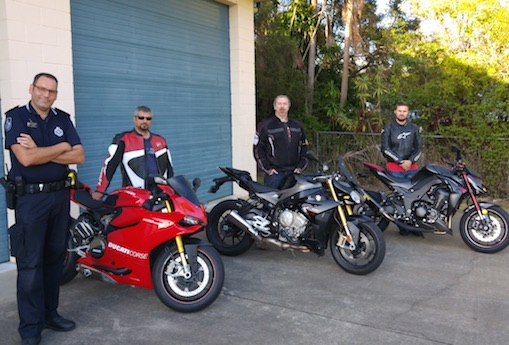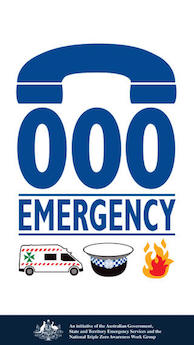https://youtu.be/xcPJ1dKpqos
This video is yet another reason to avoid road rage. The rider takes the time to flick the finger and yell abuse at a driver as he passes, taking his eyes off the road for s split second.
When he turns around, he finds he’s on collision course with a rubbish skip (dumpster). If you aren’t squeamish and watched it to the end, you will see the damage to his right knee.
We can’t see what speed he was doing, but even at 40km/h, you are travelling 11m per second. It’s long enough on this occasion for the rider not to be able to steer clear of the hazard he is approaching.
We don’t know thew reason for the road rage, although it could have something to do with the driver indicating a left turn and not turning. However, the drivers stops and seems to offer help.
There is no more information available, such as country (unless you can pick the language or the car number plate).
It’s not the first or last time we’ve shown road rage incidents to highlight the futility and lack of reason for road rage.
Check out this video below.
It comes from Florida is yet another great reason why motorcyclists should never take on drivers in a battle of road rage.
It started when the rider was splitting lane which is illegal in Florida. the driver took offence and a dangerous high-speed followed.
It ended with the driver spitting on the rider who responded by smashing the driver’s side mirror. Both men contacted police, and there is an ongoing investigation into the altercation.
It could have ended in disaster as two-wheeled bikes are simply no match a tonne or more of four-wheeled road rage.
Florida must be the capital of road rage, because in another incident we published in June a Florida driver intentionally ran over a motorcycle, sending the rider and his female pillion flying. They were taken to a hospital to be treated for minor injuries and later released.
Police arrested and charged the driver with attempted murder on the basis of the rider’s video evidence. But that doesn’t help the rider who is now nursing injuries and a broken bike.
Most riders have experienced aggressive, inconsiderate, rude, uneducated, distracted, dangerous and plain incompetent drivers on the road, but that is no reason for road rage.
Motorcyclists are vulnerable road users and in road rage situations, we can often come off second-best, like the rider in this video.
https://youtu.be/UpjZNUWNaww
Queensland Police Senior Sergeant Ian Park who created the #ridesafely4me Facebook site says he’s not sure if it’s perception or reality, but “our roads appear to be becoming angrier places”.
“Unfortunately, it seems to involve individuals from all road user groups as both the victims and the perpetrators. Motorcyclists and bicyclists are of course the most vulnerable due to the lack of physical protection around them. But the fundamentals of personal safety of the roads are no different to anywhere else,” he says.

IAN’S TIPS FOR HANDLING ROAD RAGE
If you find yourself feeling unsafe as a result of the actions of another road user, the first priority is to remove yourself from the situation as safely as possible. Unfortunately far too often incidents of poor behaviour by one road user to another are only exacerbated when the ‘victim’ retaliates. If another party chooses to yell at you, beep their horn or flash their lights – so what? Let them get it out of their system and get on their way. Inflaming the situation by ‘biting back’ rarely assists, and often only makes the situation more unsafe for everyone.
However if the other party continues to behave in a manner that makes you feel unsafe, then consider your environment. Perhaps pull into a service station, licensed premises or shopping centre that is likely to be fitted with external CCTV. This will often discourage the aggressor from taking the matter further if they know their actions (and registration details) are going to be recorded.
If no such place is available continue to drive without reacting to the aggressor until a place of safety is available, avoid making eye contact and attempt to disengage from the situation as best and safely as you can.
If you feel that you are in imminent danger, pull over and call triple zero (000). Don’t forget that ‘000’ from a mobile phone doesn’t necessarily go to your nearest operator, so always be ready to say ‘I need police in (name of City/town or nearest regional centre)’.
When speaking with a 000 operator, pass on relevant information that could assist police to investigate the matter, for example, registration details, descriptions of the person/s in the vehicle, time, date, correct location (in case there are traffic monitoring cameras located nearby etc.), descriptions about any features of the vehicle that are not standard (i.e. post factory fitted wheels, decorations, accessories, damage).
If you carry any kind of video recording device, ensure the footage is set aside so that it doesn’t get recorded over before being provided to police. Make sure you don’t just secure the footage of the incident – also keep footage leading up to and beyond the incident to help clarify any potential counter claims by the other party that it was actually you that was the aggressor.
If the situation is over, but you are still of the belief that the matter warrants investigation with a view to action by police, you always have the right to report it. You can either attend your nearest open police station to speak to someone, contact the non-urgent police reporting number which is now 131 444 in almost all Australian Police Jurisdictions. Similarly most policing services across Australia also provide on-line reporting services. Just search the police service in your State or Territory to find their websites and follow the prompts.
Be mindful, however that any complaint of an incident involving one person upon another without any supporting evidence is often difficult to successfully prosecute. A successful prosecution requires sufficient evidence being presented to a court to determine that an offence was committed beyond reasonable doubt.
However, this should not prevent you from reporting the matter, but is something to keep in mind if police determine there is not sufficient evidence for a matter to proceed. It doesn’t necessarily mean police don’t believe you! If you provide police with a video recording you must be willing and able to give evidence.



